Ecological Restoration
Ecological Restoration is the study of degraded, damaged or destroyed ecosystems and then taking actions to reestablish the entire ecosystems structure and function, bringing it back to health, to its original pre-disturbance state, a healthy state close to the original, or a state where natural regeneration can take over and return it to its pre-disturbance state.
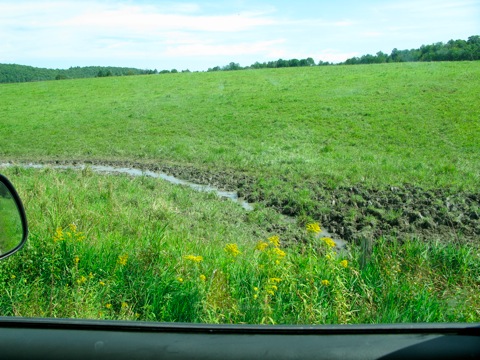
seasonal stream damaged by livestock
When cattle are allowed to be near seasonal streams like the one above they do a great deal of damage. The vegetation that is stabilizing the area is degraded or lost which results in soil erosion and the water quality of the stream is impaired. Cattle also like to stand in the cool wet areas during hot weather and will defecate in these locations which increases the nutrients in the waterways and further harms the surface water.
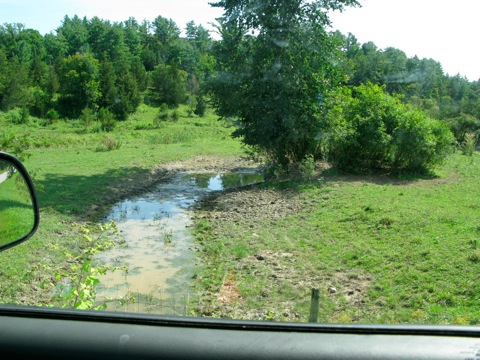
stream damaged by cattle
Here is a stream that usually runs the whole year, it is easy to see how livestock have degraded this waterway. Practices that protect water quality have to be created, enforced and funded to insure the health or our waterways.

Lake Champlain algal bloom
The high nutrient load that is found in Vermont’s waterways impacts the environment by degrading natural communities. Lake Champlain’s water quality is adversely effected by several land use practices within its watershed.

South Fork flooding North Cross Road
I believe that we are having more severe weather than we have had in the past. Scientists are saying that heavy rain events are more likely to take place as our climate changes. Flooding is costly to towns with the resulting washouts of graveled roads. By protecting wetlands we can mitigate the damage that is done during floods.
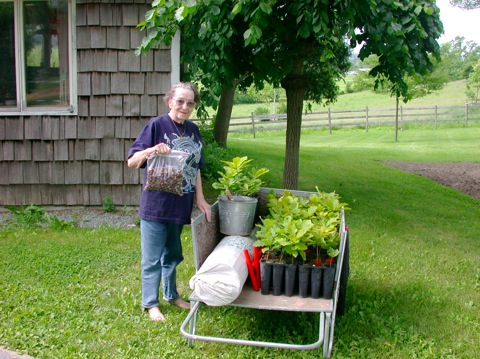
seedlings and acorns from local seed source
Here is my mother with 100 Bur Oaks that where about to be planted along the Hubbardton River. These seedlings are now growing in an area that we use to pasture our cows when the dairy was operating. These oaks where the beginning of over a thousand clayplain tree and shrub species planted within the floodplain. The clayplain forest was the natural community that once existed on the clay soils present in the Champlain Valley. Only a small percentage of this forest type remains today but efforts are being made by various non profit organizations to reestablish it to some of its former range. Farmers and other landowners have seen the value of protecting riparian areas and are restricting certain land use practices to improve water quality. Clayplain forest restoration is taking place in some of the areas that have been taken out of active farming. The vegetative buffers that get established between agricultural practices and bodies of water act as a filter which protects streams, rivers and wetlands from high levels of nutrients and eroded soil. The speed of the run off water is slowed as it travels down hill through this vegetation which allows more to be absorbed by the land thus reducing flooding.
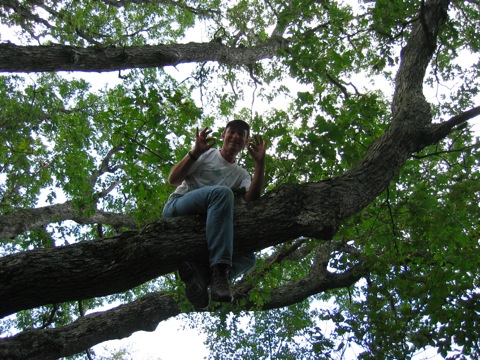
collecting White Oak acorns
It is important to use locally collected seed to produce the trees and shrubs used in ecological restoration. By using our native seed source we protect the genetic integrity of our unique trees and shrubs, several of which are at the northern extent of their range.

Shagbark Hickory nuts
I have found that direct sowing Shagbark Hickory nuts is more successful than planting transplants. Here is a handful of nuts that I collected and planted along local streams.
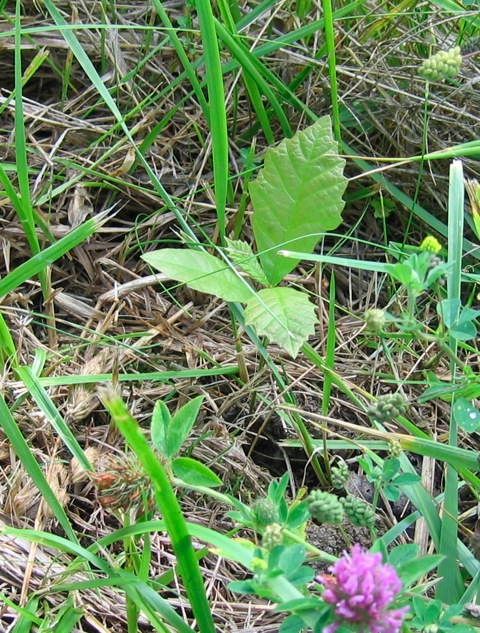
Bur Oak seedling
Here is a Bur Oak seedling that I planted as an acorn in the riparian zone of the Hubbardton River. If 5% of the nuts that I plant live to become trees I would consider that a success. I can quickly collect hundreds of acorns to use for direct sowing and the amount of labor that goes in planting nuts is much less than the planting of seedlings.

bur oak transplant left, direct sown bur oak seedling right
I conducted an experiment of how direct sown acorns will do compared to the planting of transplants. Early observations have shown that this is a viable technique in doing the restoration of some species.
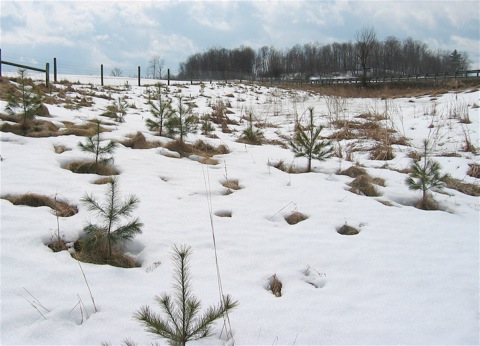
White Pines planted in riparian area
Here are some White Pine that John and I planted in an area that livestock had been fenced out of to protect a stream. These trees where planted in 2001 and this picture was taken in March of 2005. These trees got no care after they were planted and I believe that White Pines are a great species to use to establish a tree cover. I have never seen deer browse of rodent damage on White Pine. In 2011 these trees are above 6 feet tall and doing very well.
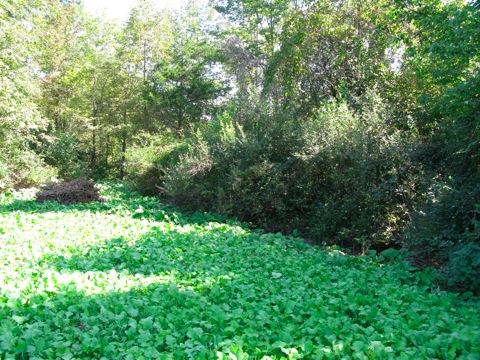
dense growth of Honeysuckle
The removal of invasive plant species is a big part of ecological restoration. Above you can see the dense growth of honeysuckle on the edge of this wooded area.
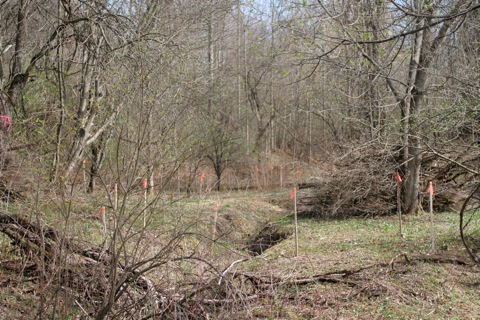
monitoring invasive control
Above is an area where I removed woody herbaceous plants during the fall of 2005. I placed stakes next to the locations where I cut Honeysuckle, Japanese Barberry, Rosa multiflora and European Buckthorn. Hand pulling of the above species was done in this area as well as using a garden fork to uproot them.
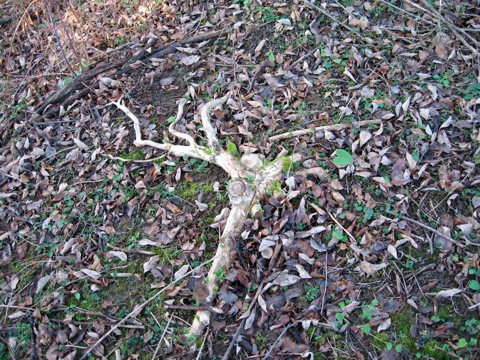
large Honeysuckle stump
I have found that the bigger the bush the less likely there will be any regrowth. When there is regrowth it is easy to brake off the suckers, removing this growth robes energy from the plant and makes it impossible for the invasive to survive.
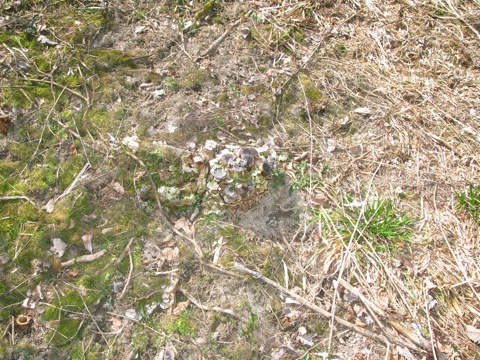
dead Honeysuckle stump
In the center of this picture is the dead stump of a Honeysuckle which now has fungus growing out of it. 
uprooted Honeysuckle
Smaller plants of honeysuckle are removed by using a garden fork. I have gotten to be skilled at how to remove these bushes and know when one is to big to handle.
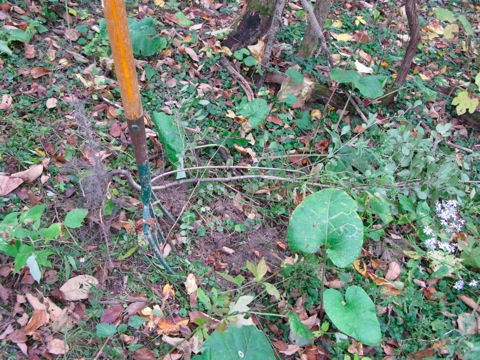
uprooted European Buckthorn
European Buckthorn is a more difficult invasive to dig up with a garden fork and is more likely to regrow from a stump but I’m still having success controling this species.
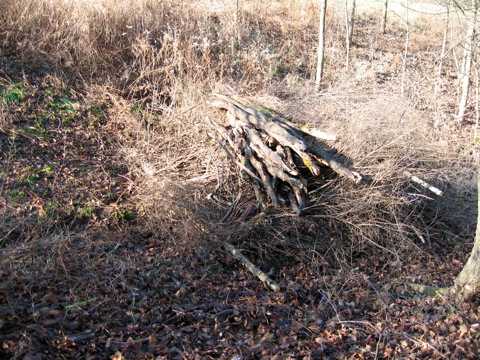
brush pile helping with erosion control
Since I’m removing a lot of invasives by root I need to be careful where I place them afterwards. I add these pulled up plants to existing bush piles so that the roots are elevated and will dry out. There are a few locations that I’m removing invasives where I’m using the placement of bush piles to trap sediment from eroding into streams.
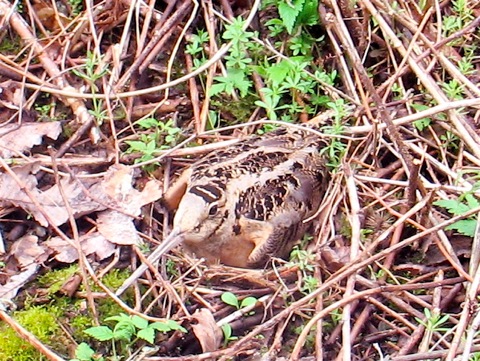
Woodcock on nest
The woodcock in the above picture had her nest partially in the brush pile featured in the previous photograph.
White Oak seedling
As I remove invasive plants I’m always looking for seedlings of native trees and shrubs that will be able to replace the exotic plants. Above is a White Oak seedling that I found growing with Honeysuckle all around it. I find this seedling very interesting since it is growing far from the nearest White Oak, this shows the success of seed dispersal. The following three pictures are of other species that I have found as I have been removing invasives.
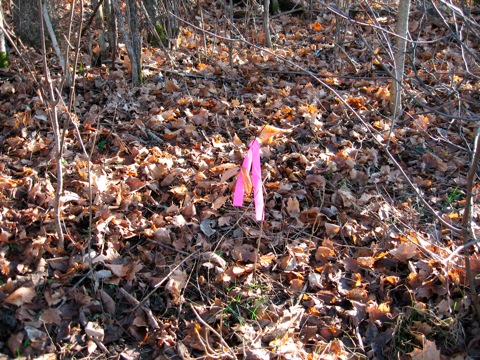
American Beech seedling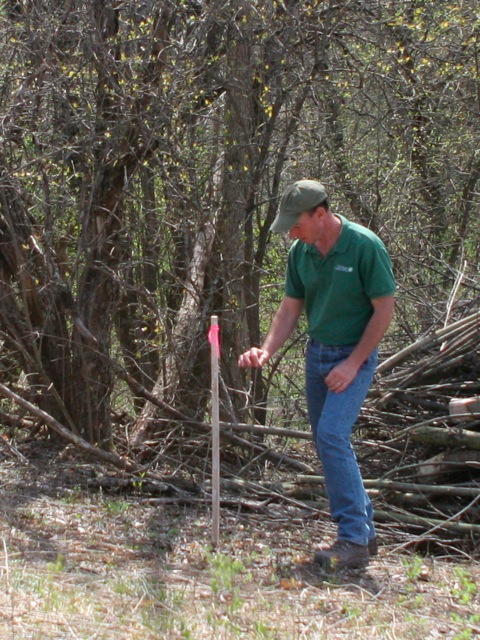
Bur Oak spring 2006
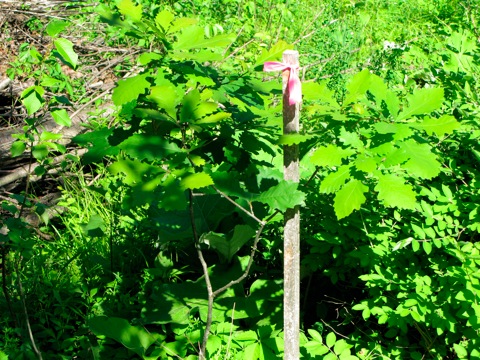
Bur Oak 2008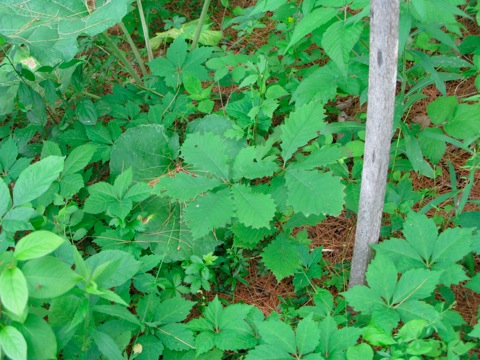
Swamp White Oak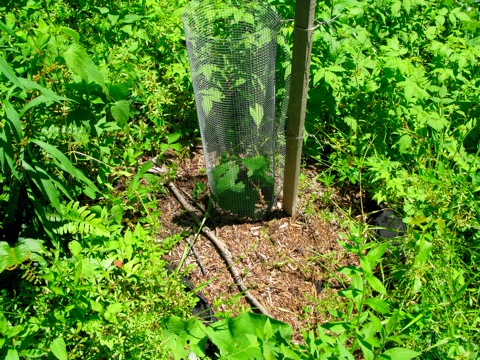
Swamp White Oak transplant
Since there are few oaks on the property I have been planting transplants into areas where I have cleared invasives, above is a Swamp White Oak in it’s first year. In order to protect the young oaks from rodents and rabbits I have placed a wire screen around the seedlings. I have found that some areas where I’m planting oak seedlings it’s important to give them this protection. In areas where there is more shade and less herbaceous growth I have had a high success rate with no protection.
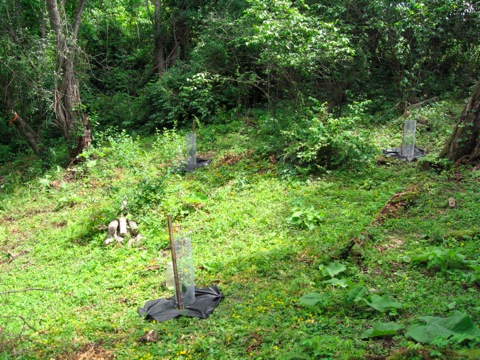
Bur Oak transplants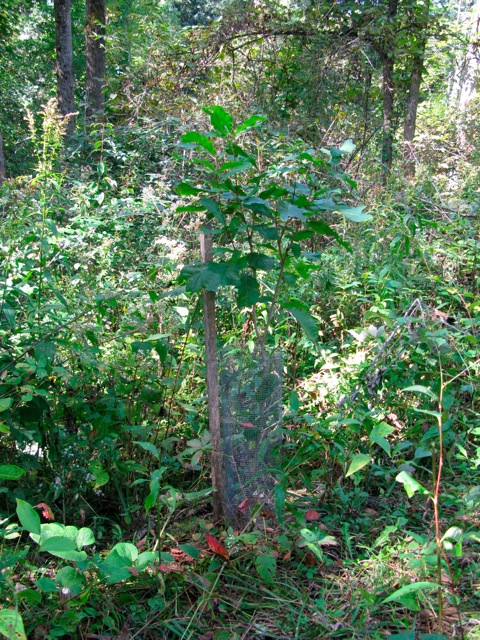
Bur Oak in it’s third year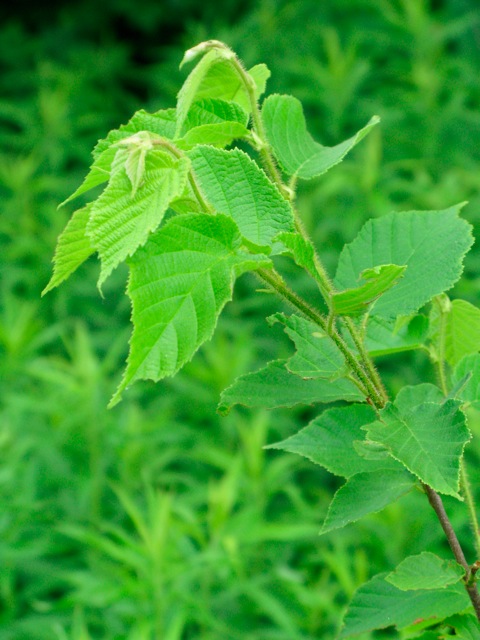
American Hazelnut
American Hazelnuts are at the northern extent of their range in our area. I find hazelnuts to be a good species to plant at restoration sights since so many types of wildlife eat it’s nuts. I have found that it is unnecessary to protect Hazelnuts from rodents since I rarely see any damage.
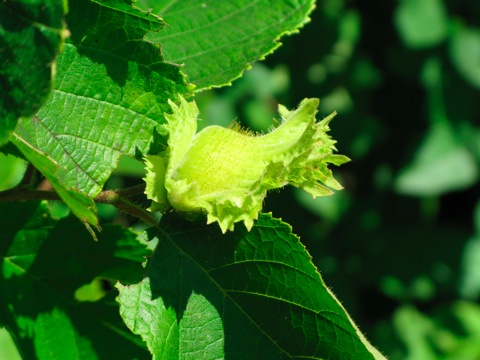
nut of American Hazelnut
transplant protection
In some areas that I have been planting oaks I have had a hard time with deer browsing on the young trees. I have been successful in deterring deer by hanging bars of soap from a stake near the trees.
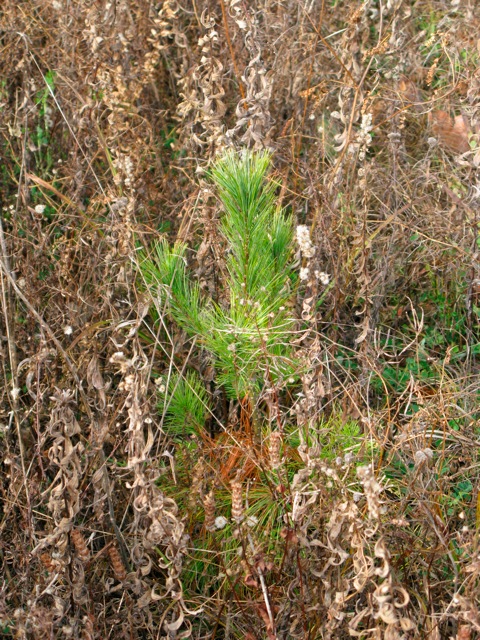
first year White Pine transplant
Here is a November picture of a White Pine seedlings that I planting spring of 2009. This young tree stands a good chance of surviving.
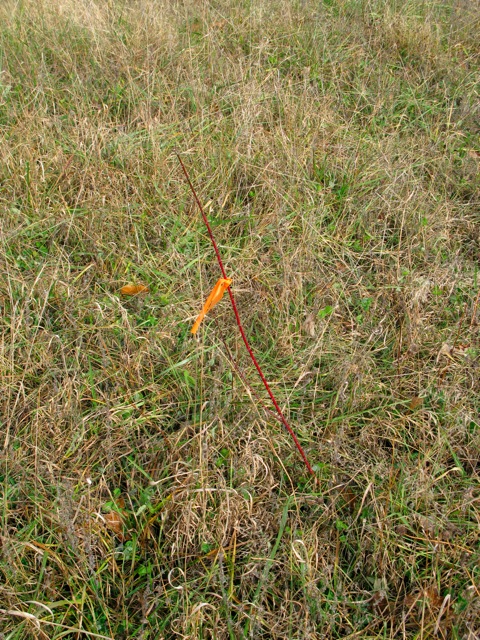
first year Silky Dogwood transplant
Silky Dogwood is a great plant to use in riparian restoration since rodents leave it alone and it is lightly browsed by deer. This species is tolerant of wet conditions and forms dense growth that creates good habitat for various animals and fruit that is eaten by many game and song birds. As we do our restoration we need to look at each project and evaluate what is unique about the location and tailor what we do to the needs and challenges of that area.

Northern Leopard Frog
Amphibians and all of the biosphere benefit from non chemical control of invasives.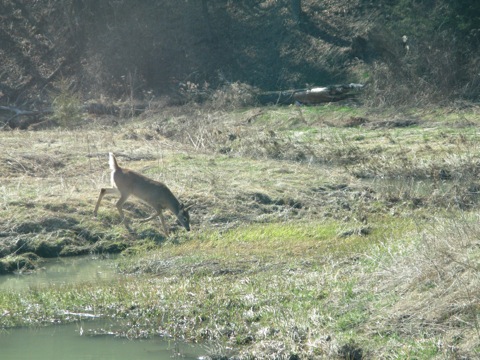
fit to drink
There is a chance that this doe’s descendants might approach the above stream protected by the cover of various trees and shrubs. The water will stay cool in the shade of over arching trees and the clean water flowing below will offer a habitat that supports a diversity of aquatic plants and animals.
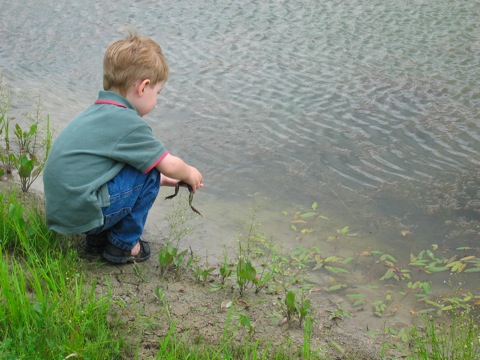
healthy productive wetlands
The positive things that come from focusing on ecological restoration and improving water quality are endless.